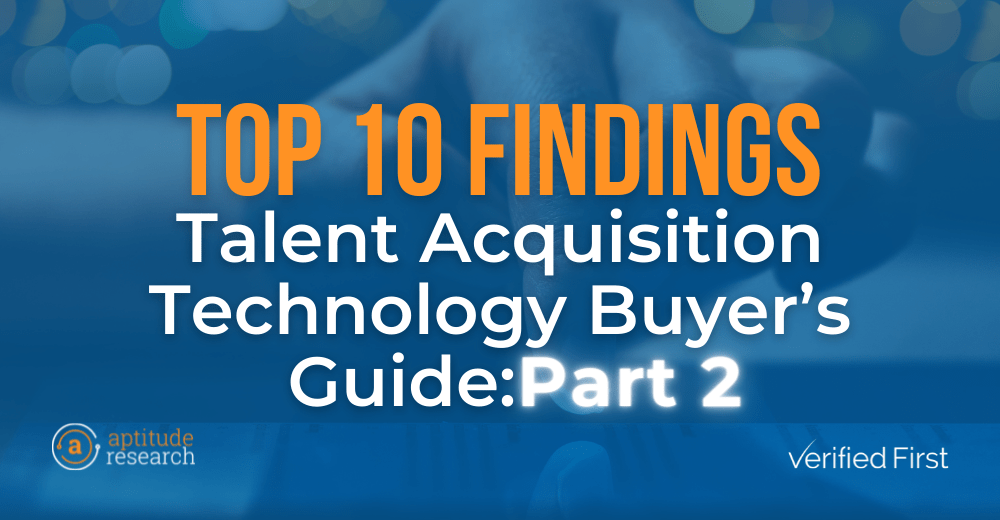
Earlier this month, I joined Ben Cornett, Director of Marketing at Verified First, to talk about changes in the talent acquisition tech landscape. It has been quite a year in TA technology with companies increasing their investment in solutions, traditional providers reinventing themselves, and startups entering the market every week. Although this dynamic market brings excitement and opportunity, it makes buying decisions incredibly complex. Companies must consider partnerships over product capabilities and price. But, understanding key trends can feel overwhelming. Ben and I spent time talking about what trends matter and what should be ignored. To explore what is driving buying decisions today, we’ll continue with part two of the top 10 findings from the Talent Acquisition Technology Buyer’s Guide and the HR at the Table webinar on The Current State of TA Technology: 2021 Trends.
[Continuation from the top 10 findings: Talent Acquisition Technology Buyer’s Guide] To help you make sense of the ever-evolving technology landscape, here are the final 5 top findings:
Businesses and candidates don’t have a full grasp of the recruiter role. While an organization’s main focus is on the company's priorities for candidates, they often neglect recruiter mental health. With the stress of recruiting during a pandemic, recruiters are feeling overwhelmed, burnt out, and are working harder than they ever have before.
What is the main culprit? Recruiters feel overwhelming pressure to do more with less, and 40% of companies have had to downsize talent acquisition functions last year. On top of struggling to use what they have, technology providers are adding new functionalities every week, causing frustrations as recruiters struggle to adopt these solutions.
They are not alone in their frustrations, though. According to Aptitude Research, the talent acquisition market is more complex with new categories, players, and partnerships:
As we see a direct impact on the recruiter role, we are going to see more replacement and adoption of talent acquisition technology solutions to lift that administrative burden and help them do their job more effectively — something that is becoming increasingly important as both companies and candidates want to feel secure in their decision.
In the last year, we have seen top pain points within talent acquisition technology align as companies identified struggles relating to price, data management, ease of use, product capabilities, and successful integration.
These challenges are a result of the complex nature of talent acquisition technology and the number of solutions in place.
Additionally, one shocking discovery is that only one in two companies measure the ROI of their talent acquisition technology investments.
To assist you in calculating ROI:
Why does this matter? Failure to measure the value of your talent acquisition technology investments can create neglect in recognizing top pain points and lead to internal frustrations and challenges down the road.
The ATS has proved to not be enough in the modern talent acquisition life cycle. Employers are finding they need to engage candidates even before they apply so they can streamline relationships and represent a strong employer brand to attract talent.
The ecosystem of talent acquisition includes but is not limited to:
On top of that, many providers have enhanced their interview management capabilities, have dabbled with AI-matching, and have made commitments to diversity, equity, and inclusion (DEI). Needs are evolving and the modern talent acquisition life cycle needs to include an end-to-end platform that supports attracting, recruiting, and hiring talent.
Reducing bias is also a key driver this year for 18% of companies. As companies look to improve their approach to diversity hiring and ensuring inclusivity, reducing bias through every stage of talent acquisition is critical. Some companies are looking at providers to blind resumes or interviews, while others are using AI matching and solutions to improve their job descriptions and communication with candidates.
The foundation of a strong talent acquisition tech stack includes integration, data management, and automation. Companies with a foundation that consists of these three areas are more successful with technology implementation and adoption.
With many exciting new TA technology solutions in the market, the pressure and excitement to adopt has increased. Unfortunately, integration follow-through is not something often considered. In fact, one in two companies aren’t even thinking about integration before they start to evaluate providers and one in three companies actually identified integration as a top challenge.
To prepare yourself for integrations, consider asking:
Without understanding how technology solutions will integrate within your current TA systems, companies risk a lack of consistency in experience, data, and delivery.
As technology investments rise, it’s important to fully understand their functionality to best support your organization. When investments fail to (1) match user abilities, (2) meet organizational goals, (3) perform as expected, and (4) integrate properly, you risk your return on investment.
The research finds that:
To keep up with the current state of TA technology, download this year’s guide and check out part one to get the rest of the guide’s top ten findings!